
Sandra Merkatz
-
Posts
110 -
Joined
-
Last visited
Posts posted by Sandra Merkatz
-
-
When it comes to movies (or series) about women loving women, there are not many good examples that come in my mind. Unfortunately, most of the stuff I have seen is full of cliché and stereotypes, some of them are clearly just soft-porn-movies with a better plot. Movie industry seems to have a problem to make convincing movies with this theme.
But there are three exceptions that I really like and which I can recommend!
Number 1:
“Mädchen in Uniform” (1931, Director: Leontine Sagan) ["Girls in Uniform"]

This movie is one of the greatest “lesbian movies”, although the lesbian-theme isn´t that strong. I don´t want to describe every plot in detail, just a short summary: The plot takes place about 1900-1910 in Germany (although there are some minor hints that the story takes place in the 1930s, but nevermind). After the death of her beloved mother, Manuela is sent to a Prussian girls-residential school, that is extremely strict and quite horrible. Only one teacher, Fräulein von Bernburg, is kind and fond, and Manuela falls in love with here. The teacher is torn, because she also has feelings for Manuela, but must not show it. In the end Manuela tries to kill herself, but is saved at the last second, while the strict matron learns a lesson, to what a heartless regiment can lead.
Both Dorothea Wieck as the teacher and Hertha Thiele as Manuela are doing their jobs pretty well in this early German talkie. There are, of course, no sex-scenes or something like that (1931!), just one quick kiss, but you see on their faces what they feel. The way they look at each other tells very much.
Dorothea Wieck was hired by Paramount because of her portrait of the teacher and made two movies.
Wikipedia says, that Irving Thalberg from MGM liked that movie and the sensitive portrait of that theme so much that he approved to make “Queen Christina” with Greta Garbo in 1933.Unfortunately, that movie is heavily cut today! The movie was cut for a second certification. During the Nazi-regime, the movie was banned in Germany (most likely because of the criticism of the military way they treat the girls, the criticism of authority and discipline, not so much because of the two women falling in love).
In 1949 the movie was again cut in Germany and approved for audiences of 6 years and older. This cut version is the one we have today. Nobody knows where the missing scenes are, or what they show. I hope they will be found and restored for a new Blu-ray release!
(There is also a remake from 1958, with Romy Schneider as Manuela, but that movie wasn´t good at all and is quite forgettable, except for the matron in that movie, who is very frightening and convincing in her role).There are different written versions of this: Christa Winsloe, a german-hungarian lesbian writer, wrote a play in 1930 with this story, in 1931 they made this film of it (Winsloe wrote the script). After the movie, Winsloe wrote the novel after the film (and added the original ending, in which Manuela dies after her suicide) in 1933.
Winsloe and her girlfriend got killed in 1944.
Number 2:
“Desert Hearts” (1985, Director: Donna Deitch)

I was reading about the story of the movie and thought “Ok, another lesbian movie, this time from the 1980s, that means lots of unnecessary nudity and all that stuff”. But how I was wrong!
Here´s the beginning of the story, excerpt from Wikipedia:In 1959, Vivian Bell, a 35-year-old English professor at Columbia University in New York City, travels to Reno to establish residency in Nevada (a process that takes six weeks), in order to obtain a quickie divorce. She stays at a guest house ranch for women who are waiting for their divorces to be finalized.
One of the women (played by Helen Shaver), is a lesbian who has short affairs, and she falls in love with the professor (played by Patricia Charbonneau), who is most of the time quite unsure, till eventually it comes to a first kiss. I won´t give away the ending.
What I like about this movie is, that both women are NOT supermodels, they look normal, and the story takes place in the 1950s, which makes such a story more interesting in my opinion. And this movie is not like so many productions from today: it does not play cheesy (piano)music when it comes to romantic scenes. There is only ONE sex-scene, but one of the best I have seen, not only because it doesn´t use any music at all, it´s filmed sensitive and erotically but NOT voyeuristic! And: the scene is not unnecessary, it doesn´t slow down the story; no, it shows how botch characters act and react to each other. You don´t have the feeling that the movie is try to give you some porn, but it tries to develop characters. Even Rogert Ebert wrote:
Then there is a sex scene of surprising power. Although "Desert Hearts" is not in any sense an exploitation movie, it does depend on that sex scene in order to work - because the movie's structure is so clearly leading up to just such a scene. (...) Then, eventually, comes the big love scene, and the reason it is so strong, I think, is that the director, Donna Deitch, didn't try to make it fancy. Instead of turning it into some kind of erotic music video - in which the real subject is not sex but the director's cleverness - she lets the scene build according to its own rhythms. The result is one of the few genuinely powerful erotic passages in recent movies. (Where did so many directors get the idea that passion in the editing room equates passion on the screen, and that if you have lots of fancy cutting, that indicates great sex?)It´s also not a prude scene, where the actresses try to hide themselves from the camera. (I think maybe it was easier to make such a movie in the 80s …. Think of the movie “Splash”, where you can see the naked breasts of the mermaid – in a kids movie! Unthinkable today.)
And the ending is not an ending you would expect from such a movie.
Number 3:
“Tipping the Velvet” (2002, Director: Geoffrey Sax)

This is a TV-miniseries in three parts from the BBC, based on the 1998 novel of the same name by Sarah Waters. (Please ignore the horrible cover of the DVD! The movie is not like it looks here!) When I read the plot, I was interested: it takes place in the 1890s in Victorian England, and it was something about a girl who is fascinated and later falls in love with a female crossdresser, who plays a pants-role on stage (when a woman plays a male character on stage). I´m a big fan of the theatre and much more of the opera, so I wanted to see this, but I had doubts: this was produced in 2002, so this will surely be another kind of “The L Word” or something like that.But again: I was totally wrong.
Together the movie lasts for 177 minutes, and it´s hard to describe the plot, because there are so many things going on. Basically it´s about the young woman Nancy Astley (played by Rachael Stirling, the daughter of Diana Rigg … I knew her face looks familiar while I was watching this!) who visits a theatre and is fascinated by an actress who plays a guy on stage. They fell in love, but then she is betrayed by the actress for another man, and also because the actress has a problem to be officially together with a woman. After that disappointment, Nancy travels around searching for the right woman, and has a lot of adventures. She works in the theatre and plays a man herself, she is a prostitute for a short time, then she is kind of a callgirl for a very rich older woman, who has decadent costume parties, etc. etc. I will not give away the ending here too, if she will find the right one or not.
So what do I like about the movie? First, the actors, especially the main character, played by Rachael Stirling, who is also not a supermodel but very charismatic and likeable, with an expressive face. You really feel for her when she is sad or happy. The story itself isn´t that great or very creative, it´s more the way they filmed it. Altough it´s a period movie and there are some dramatic scenes, it´s not really a drama, because there is much humor in it, it´s a lighthearted movie.
Yes, there are some sex-scenes, not only one, but they are tasteful, not voyeuristic, and always important for the plot, and they differ in the way they are filmed or staged, so it´s not always the same thing over and over again. When a sex scene happens without any feelings, the camera shows it from a distance, when there is more passion, the camera also is more sensitive, with the focus on the faces; sometimes you see naked bodies, but, as I mentioned, not in a voyeuristic way, it feels natural and like a minor matter.
But what I registered is that relaxed, laid-back feeling this British production handles nudity and sex-scenes. They show that stuff and you never feel uncomfortable, everything, even the more “weirder” scenes (when it comes to the rich woman) are handled very carefree. It´s not a (S)Exploitation movie, the actresses keep their dignity. It doesn´t say "Hey, look here, a naked body, isn´t that a big thing?!"Some of those scenes also have some kind of humor in it, when they laugh together or the camera shows scenes from a weird angle or there are fast cuts.
I love American movies, but when it comes to nudity or sex, I register two extremes: either the actresses wear bras in the bed or cover themselves with a blanket and everything is very prude and "family friendly", or they have much freedom (like HBO productions such as Game of Thrones), and they use this freedom to show as much as possible, even if it doesn´t add anything to the story.
"Hey, let´s show some genitals! Why? Because we CAN!!"
Of course there are exceptions (like “Desert Hearts”), no doubt. But I think British productions handle that things more relaxed.
Finally I can recommend those three movies to everyone who is interested in seeing good "lesbian movies" with good actors and a good story, without porn, without (S)Exploitation, but feeling and passion, when it fits to the story and the characters.
Greetings,
Sandra
-
I like Werner Herzogs remake of "Nosferatu". Of course the original can´t be beaten, but it still has some good scenes and a creepy atmosphere. But unfortunately there are no good versions out there. At the moment there are three different Blu-rays:
UK German Version Blu-ray by British Film Institute
US German Version Blu-ray by Shout! Factory
GER Blu-ray by Studio Canal
This is the US version:

The US- and the DE-Blu-ray both have a horrible DNR picture. The UK version seems more natural, has grain and doesn´t look waxy, but it´s still not a very good picture, looks too soft to me, so I wouldn´t buy that one either.
Some comparisons between the UK and the US version:
You can see the grain is gone in the background in the second version, and the skin looks more "flat".
But look at this detail shot of the same picture:
While the pupil on the UK version looks like a circle, on the US-BD it looks like a hexagon! Also some details in the iris are missing, and little wrinkles on the face disappear.
Another example: of course a very grainy picture, but the face looks more natural. On the DNR-version, the face appear a little bit more waxy, but there are ugly artifacts all over the picture. Notice how the hair on her nose disappears in the DNR version.
By the way, the colors are also questionable.
On the old DVD Nosferatu looks pale, and you can see his black coat. On the Blu-ray his face has a more natural skin-tone and the coat disappears (black crush?).
I´m hoping for a better relase of this movie, with the grain and the correct colors, from a good master.
Greetings,
Sandra
-
That really doesn´t look good at all, you´re right.
(btw I do the images by making a screenshot and then make it smaller and post it here :)
Greetings,
Sandra
-
That are nice examples! I also think that a period movie shouldn´t look like a "modern" movie. In "Dracula", Coppola even uses a real silent movie-camera from back then for the scene in which Dracula walks through the crowded streets of London, but that´s of course an extreme example.
To keep the look of back then I think you should also don´t use CGI. That´s what I don´t like about "The Mummy" from 1999. The setting is in the 1920s, the colors and everything also look "old", but the Mummy and other creatures all look like in a modern computer game. Doesn´t fit at all.
Coppola did not only care for the colors and the sets and costumes to look old, he also just uses film-techniques and stage-tricks from that time, so it doesn´t look too modern.
Greetings,
Sandra
-
One of my favorite 'historical' films was "Caligula"(1979). Of course with all the 'porn' added in by Bob Guccioni, the received professionals all disowned the film, ranging from Gore Vidal who wrote the book and script, to major actors, etc.
But in a way, it stuck fairly closely to Seutonius' account of Caligula found in his "Twelve Caesars", written in 121 CE.
Vidal sort of expanded and modernized the story found in Seutonius... who expects any one to study Latin these days to read Seutonius directly.
I never got why they put in all those porn elements. I´m not prude at all (and I will never understand why on Imdb in the Parents Guide "Sex & Nudity" comes BEFORE "Violence & Gore" and "Drug or Alcohol", as if nudity is worse then violence in a movie), but I think that an erotic scene or a sex scene should make sense for the story, and not just being there to make the audience horny.
Just seeing some people having an orgy is boring for me, I want to see a story.
Greetings,
Sandra
-
I have been following this conversation a bit. I wanted to say a few things.
Sandra, I believe all of the movies you mentioned involve a strong attachment to commerce - From Big to Monty Python to Ben Hur. The film industry has been a business since its beginning hence the film "industry". Any major motion picture of any time period involved large amounts of money and filmmakers always made sacrifice and compromise because of money - That compromise goes beyond simple production choices (we need to use this small set instead of this big expensive one) but also from its very core film has favored entertainment and ticket sales.
Of course the movies I mentioned are not tiny independent movies. Altough, "Life of Brian" was only possible because George Harrison payed for it. No studio wanted that movie!
I also have nothing against mainstream, as long as I don´t feel like the filmmakers are thinking I´m an idiot.
For example, I love the first Indiana Jones movie, because it was an interesting story, and they put much effort in it, with all the practical effects, the matte paintings (the very last shot of Area 51 with all those boxes took 3 months to paint!), the real stunts and everything. The movie didn´t take itself too seriously, it wants to entertain the audience.
But when I see an action movie of today, I always see fast cuts, over the top-stunts, shaky cams and that stylized look, I don´t feel entertained, I get the feeling that I watch a product of a studio who thinks I like this and pay for this, a product only made for earning money. Not to entertain me. They made it because they analyzed what the big audience like, not because they had a good idea for a new story.
When "Gladiator" was out, I hoped for a good movie. The director was Ridley Scott, and after a long time it was one of those movies that is set in ancient times, like the classics (Spartacus, Ben Hur, Quo Vadis, etc.)
In "Ben Hur", the stunts in the chariot race, and the race itself, was filmed with a "normal" camera. Not a shaky cam that tries to fake excitement. The chariot race is exciting WITHOUT all those fast cuts!
But Scott did that in Gladiator, you can´t see anything in the action scenes. I get a headache when I watch this. (Same thing with concerts nowadays. When you watch a rock concert from the 1970s, you have long shots of the guitarists playing his solo etc. Today every 1 or 2 seconds a cut. Horrible!)
After Gladiator was successful, it was clear that there will be many other films like that, and there was. Troja, Kingdom of Heavens, etc.
"Oh look, that ancient movie was successful, let´s make such a movie too, the audience wants this right now"
"Oh look, American Pie was successful, let´s make another teenie movie with a lot of innuendos too"
"Oh look, people liked that comic-film, let´s make a movie of Hulk, Fantastic 4, Batman, Superman, Spiderman etc. too"
"Oh look, the audience loved that CGI movie for kids, let´s make a movie about talking cars, and call it "Cars", complete CGI"
"Oh look, people liked "Cinderella" let´s do remakes of Jungle Book, Pete´s dragon and Beauty and the Beast too"
"Oh look, Game of Thrones, that series with a lot of violence and porn-scenes is successful, let´s make that kind of series too, and call it Spartacus, Rome, Versailles, Borgia, Marco Polo, The Tudors, Odysseus, The White Queen, Camelot or Casanova"
When I see a movie today, I have the feeling I´m just watching the result of conferences of studio bosses who discuss what will bring the most money.
Even John Cleese says, movies and Tv-series today are not made by filmmakers but by studio bosses.
I just opened Imdb right now to see what´s Now Playing, with the Box Office.
Wonder Woman
Of course, another comic-movie. 58,5 Million Dollars. There will be Wonder Woman 2 soon.
The Mummy
A movie about a mummy. Because we don´t have much movies about mummies ... very creative. Of course with a superstar (Tom Cruise), that will bring even more money. What does that movie add to the Mummy franchise what we didn´t see yet? A female mummy? That´s not new. Better CGI effects then in the 1999 version?
Captain Underpants: The First Epic Movie
I don´t know what that is. I don´t even want to know. But it makes 12,2 Million dollars. Captain Underpants. Welcome to 2017.
Pirates of the Caribbean: Dead Men Tell No Tales
Another sequel. Pirates of the Carribean is a success, so let´s keep doing those movies till nobody wants to see it.
Guardians of the Galaxy Vol. 2
Vol. 2 of course, part 1 was successful, the audience will probably also watch part 2, and we get make money money money money money!
Oh, I just see, Cars 3 is coming! What a surprise! Another CGI movie about talking cars, can´t wait for part Cars 4 ... except when the movie isn´t a success anymore, then we probably get a CGI movie about talking robots or pets ... oh wait ...
Greetings,
Sandra
-
On YouTube I saw some videos, where they play a whole movie (not just some scenes, but the whole movie!) on the big screen, while an orchestra plays the music. You still hear the actors talking and all the sound effects in the movie, but the music comes from a live orchestra.
Here is an example for "Raiders of the Lost Ark":
What do you think of it? Do you like the idea or not? Have you been in such a show?
I like the idea, and it reminds me of the old days of cinema, when there were musicians who accompanied a movie, in the silent film era. It gives the orchestras, the musicians a job too; many musicians lost their jobs back then when silent movies were gone.
Greetings,
Sandra
-
ah I see.. all of the classic films then.. :).. ok I get it this is a wind up.. you had me fooled.. nice one.. peace and love ..
I don´t really care if a movie is a "classic" or how old it is, only if it´s good or not. There were many bad movies too back then, but I watch those only with the guys from "Mystery Science Theatre 3000" or "Rifftrax". ;)
Of course there were bad movies that played in the same time as Ben Hur, but Ben Hur was different, it was not as cheezy, it had good actors and everything.
Or take "Big" from the 80s. I never watched that movie because I thought "Oh no, another 80s coming-of-age-comedy, please not". But a friend convinced me to watch it a few years ago, and I was surprised, how different it was. I thought the ending is predictable, but no, the ending was very different and unusual, that´s why I like the movie.
And of course stuff like "American Pie" will never beat the humour of a Monty Python movie. I´d rather watch "Fawlty Towers" than "2 Broke Girls". Not because FT is older, but because I see that FT is more creative. Basil Fawlty running out of the picture, coming back with a branch and beating his car is just funny ^^
Greetings,
Sandra
-
I watch movies that are in any way creative, movies where I have the feeling that it was primarily made to tell a story, to be creative and maybe even innovative. When I look at my shelf I don´t see any picture from 2000 - 2017, most of them are (much) older.
As I mentioned I don´t have a problem that artists also want to earn money, that´s natural! But when the product, the movie, is good, when I see that there were creative minds behind it and not studio bosses with dollar signs in their eyes, then I have no problem with it.
I only have a few Blu-rays (mostly because the movies I´m interested in are either not available yet on BD or the quality is bad).
I have "Bram Stokers Dracula", which was very creative, done only with practical effects and techniques from the early days of filmmaking (shooting backwards, double exposure etc., no digital effects).I have "From Dusk till Dawn", because I like the actors and the sudden chance from a road movie to a vampire-horror flick.
I´ve got "Young Frankenstein". I´m not a Mel Brooks fan, but I love the chemistry between the actors (accordings to Imbd after the last shot the actors didn´t want to finish shooting and Mel Brooks wrote more scenes in order to continue shooting), and how he recreates the look of the original Frankenstein, with a very grainy film stock and the original laboratory set by Kenneth Strickfaden.
I also have "Big" with Tom Hanks. it´s not a great movie, but a quite unusual modern fairy tale. Not much logic, even some plot holes, but I guess you couldn´t make that movie nowadays.
Also "Splash" and "The Money Pit" and "The ´Burbs"!
I also have "Back to the Future", because the story is great AND they really cared about little details and the logic of time traveling.
Or "Batman" and "Batman Returns" from Tim Burton, because I like the style of those movies. Gotham City really looks like a gothic city, with Film Noir-elements. Those movies took Batman more seriously then the old 60s series, but they are also more like a comic. I absolutely don´t like the modern Nolan movies, Gotham just looks like a normal modern city, and they take Batman way too seriously. The only thing I didn´t like in both Burton and Nolans movie is Catwoman. Julie Newmar will always be THE catwoman for me :)
And of course I have all Monty Python movies ("And now for ..", "Holy Grail", "Life of Brian" and "Meaning of Life"). Funny and creative movies in my opinion.
But what you´ve got today? Remake after remake after remake, action movies who look like every other, horror movies who look like every other. Even movie trailers and posters look the same nowadays!
James Rolfe, the "Angry Video Game Nerd", pointed out some things in trailers they do all the time.
For example those fade to blacks at the beginning of the trailer: they show you a short scene, then fade to black, then another scene, fade to black, etc.
I watched the trailer for both new Star Wars movies - same thing. I watched the trailer for the new "Stephen Kings It" - same thing. I watched the trailer for the "Blade Runner" sequel - same thing.Or another typical thing, especially in trailers for comedy movies: they play music, and at the end of the trailer the music suddenly pauses (often with the typical needle-scratch noise), you hear a joke, then the music continues playing. You see that so often today!
Greetings,
Sandra
-
 1
1
-
-
I have to say I actually quite like the yellowy grade at the top of this thread. Looks more, I don't know, mid-century?
P
I understand you, you mean, it looks like the movie is saying "We are looking at a story of the 19th century", it creates a time-distance between the viewer and the action on the screen. While the normal color looks like "You are looking at a movie of the 1960s".
I think we generally have certain colors in mind when we think of the past. When we think of the 20s, we KNOW that back then there were normal colors and everything, but WE today know that time mostly through old b/w photos and old movies that maybe run too fast at times.
There was a photographer who took many photos between 1900 and 1910 in real color. Don´t ask me exactly how he did it, he made three photographs, each one with a different colorfilter (or something like that) and combined them in order to get true colors. Of course, because he had to make three pictures the object must not move.
This is one of his photographs, from 1909.
It´s quite strange for me to see that, because, as I mentioned before, I only know that time through old, bad pictures in b/w or sepia, that creates a distance between me and the photo. But then there are pictures like this, and suddenly there is no distance anymore, it shows that back then the colors were just like today.
Greetings,
Sandra
-
I disagree, a director hires a cinematographer for his expertise in a field that a director would know nothing about.
What I meant was, that some directors are more intererested in certain parts of movie making, others in other parts. Maybe one director is more interested in the STORY of the film, not in creative camera angles or other technical stuff.
Oscars don't mean a thing, it proves absolutely nothing.Here I agree with you. I read Woody Allen didn´t go to the Oscars when he won for "Annie Hall", and later he didn´t allow that this movie gets promoted with the mention of winning an Oscar. Hitchcock never got an Oscar.
Greetings,
Sandra
-
Another bad Blu-ray: "The Indian Tomb" by Fritz Lang, from 1959.
The comparison is between the UK-DVD and the German Blu-ray from Universum Film.
While the DVD was too dark, the BD is extremly bright, the white looks horrible, all the details are lost. I guess they also used DNR here to eliminate the worst picture problems (not the grain).
Another example for a poor picture. Again too bright, again loss of details (for example on the clothes of the two persons), very soft looking picture, soft edges, the floor looks more like plastik than stone.
Here is the famous "snake-dance" by Debra Paget. And again horrible quality. Look at the edges of the skin, what´s that?! The BD just looks like the DVD, only much brighter. No details, no nothing. Hands off!
Greetings,
Sandra
-
I think I've read that some restorers combine a scan of the original negative, which has color fading problems but is the sharpest and finest-grained source, with scans of the b&w YCM separations made for archiving, which have the original color information if done correctly but often have grain and contrast problems. Not sure how they combine those elements digitally.
That sounds interesting! And again, it would be great if they would explain that in a booklet, how they had done the restauration :(
The way they write it, to an unexperienced viewer like me it sounds like they have the original negative and used it for the Blu-ray. A regular viewer like me doesn´t know about original negatives, YCM separations etc.
No, they rather write how many stupid Oscars that movie won ... how interesting.
Thanks anyway for the information, David :)
Greetings,
Sandra
-
But a composer and a painter is one person in a room.. often under no or very little time constraint .. very different to making a large motion picture..
Not only that, they can also draw or compose what they want. Think about surrealism, that´s quite unusual paintings, not the "regular", beautiful painting of landscapes.
Or composers like Wagner. Before him, operas had recitatives (accompanied usually by a harpsichord) and arias. Aria Nr. 1 -> Recitative -> Aria Nr. 2 -> Recitative -> Romance and Aria -> Recitative -> Duet -> Recitative etc. etc.
That was the usual form of the opera.
And then Wagner came and made everything different: he made through-composed operas, no arias anymore, and a music that was VERY different than that of Mozart etc. Dissonances, a giant orchestra with many different instruments. Of course many people liked his work, but there were many people who hated his music too.
Wagner didn´t went to a company and said "Please, I have groundbreaking new ideas, I will made everything different then what the audience is used too, many people will not like it, can I make this opera?". He just wrote it.
is it not a bit of a stretch to expect the film industry to be primarily about art..Why should I watch movies then when I know that it´s more about a company making money?
A few years ago I asked myself seriously "Do we need more movies? Isn´t every story told yet in every different way?". But then I thought about it, and came to the conclusion, that there ARE people with new ideas, but the problem is the industry, that takes no risk and gives the audience always the same. Creative people with new stories don´t get a chance.
the music industry is all about money.. I filmed the 3 tenors concert tour and I can assure you its more about money that art .. look at Damien Hirst ..
Unfortunately it´s also usual to sell "superstars" in classical music today. You´ve got photoshop-covers, or "erotic" covers with a female cello player spreading her legs and stuff like that. I hate it. And I don´t buy those records.
But there are good HIP-ensembles who give great concerts, of course not in the big arenas, but in a chamber or in an old opera house. Those orchestras don´t get money like the Vienna Philharmonic orchestra, they don´t make New Years Concerts with a billion people watch it. Of course they have their own website and have to earn money, but they care more about the art, about studying sources to play the music right, to know the intentions of the composer more.
John Cleese is a very astute business man .. who had his own prod co making corp videos in the UK in the 80,s.. and why not.. its their job..
That´s not problem for me, I know he had done a lot of things like that. But the point is that back in 1969 that BBC guy let this young group do 13 shows without even knowing what to expect. In the Monty Python autobiography, Cleese also complains about the industry today. They expect a comedy series to be very funny from the first episode on, they expect a new concept to work from the first second on, but that´s not how it works! He compares it to a double-tennis-team, that has to play many, many games till they are perfect together and know each other well. A comedy group has to have some time to expercience, to see what the audience is laughing at, to try new stuff, and of course to know each other better. They need time to improve their timing etc. But they can´t because the company says "You had 2 shows, you had your chance, nobody likes it, goodbye".
Monty Python had luck. The show wasn´t a success in the beginning. You don´t hear much laughter in the first episode, because they send busses of old people there who didn´t know what to expect. But after more episodes, there were fans who liked it and ordered tickets for the show, That wouldn´t have happened if BBC had canceled it after 1 or 2 episodes.
I beg to differ. While Mozart was one of the first musical artists to 'go without patronage', at least to some extent, he did not have the luxury to put off composing, as his pay check was dependent on getting work out.
Prior to that artists were usually patronized, and required to put out music for any occasion the patron wanted... regardless of the inclinations of the artist... of course if someone was 'brilliant' perhaps the patron would give some slack but not much.
Of course there were those composers, but MANY composers or painters didn´t have a patron, they were quite poor and had problems to sell their compositions to a publisher.
My problem is not that artists also need money, that´s natural. My problem is that especially nowadays it seems to be JUST about money.
Greetings,
Sandra
-
I feel cinematographers have a unique understanding of light by observing and interpreting the way nature works, I don't think they're thinking about what works best for the story, because if you think about a film noir, why is it so dark and moody?
Well, I guess it depends on the director and his understanding of art. There will be directors who are not very interested in this topic, others are very interested, etc.
Some of them may be fans of Rembrandt and da Vinci, others are not.
But I do think that light works for a story! In a documentary I heard a good quote: Every frame of a movie is like a photograph, like a photo. The way you would arrange arrange everything for this one shot, you will do that for a movie too, usually.
I agree that not every light setting has a deeper meaning, not every light is "intellectual". Some of them are really just motivated (like the sunlight, lamps etc.), others are only there to look beautiful.
But of course you can for example give the audience hints about a character or the way he/she feels with the way you light a scene. Is a character nice? Then you would probably not use hard shadows, more soft light maybe. You wouldn´t want to have a dark shadow over his eyes, making them disappear in the darkness, because that would look more dangerous.
With the light you can draw the attention of the audience to a certain part of the picture, maybe the eyes of a character, or an object in the set.
In "Dracula", Coppola wanted the rooms in the castle to disappear in the shadows, the ceilings and other parts, so the viewer would not know where the room ends or what is there in the shadow. Also a way of telling a story.
So, in cinematography light is the imagining of the way nature works, but nowadays there are more noticeable distortions, such as when the cinematographer changes the color temperature in the camera, and we see the entire frame tinted in a certain color, like in The Matrix. Color is also a way to convey information to the viewer, they used to do it in silent films too, night scenes were tinted with a blueish tint, etc.Absolutely, that´s one of the things you can do! But also other things, like the angle of the camera. For example, in the old Batman-series (with the late Adam West), everytime they filmed a hide-out of the villain, the camera would turn a little bit so that the image is crooked. That way they show the audience, that the world of the villains here is crazy, not "normal", that creates an unnatural feeling if you watch it.
Greetings,
Sandra
-
I think you really should get onto a film set .. you will see that academic theorizing and actual making of films is very different .. very few films are shot in chronological order.. for efficiency rather than as a lazy un artistic option.
That´s what I meant: it´s about efficiency, about money, about business, not mainly about art.
If you see other art forms like classical music or paintings, you don´t have that. When a composer had an idea, he composed and composed, was playing around on the piano to find new melodies etc. He doesn´t say "OMG, today I haven´t composed a thing, what a waste of time and money!".
Or paintings. A painter paints what he likes, the way he likes it. If he doesn´t want to continue his work, he left it alone (like Leonardo da Vinci often does, there are a lot of unfinished works). The art itself is the central point, the creative process, not a schedule. (Of course there are ordered compositions and paintings, but that´s not really "free art", I don´t mean them).
Films have also been a business .. the early film makers were also business men.. Chaplin and Keating made alot of money from films..
Of course they also wanted to make money, they had to eat and live too, but I still get the feeling that back then the movie was the main thing, creativity was the main thing, to show the audience something new.
BTW Oscars didnt start till 1927.. 25 years after A trip to the Moon.. .. there were no red carpets and daytime TV shows or Im sure they would have been on them..
That´s the point! Back then it was only a movie in a cinema. People went there to see those movies and were amazed or disappointed, and that´s it.
Not sure that a film shot one angle wide shot is actually adding to the art or story telling personally.. Im glad things have moved on from the "film a play" perspective ..
Me too, but that shows that creativity back then was much more appreciated than today. Filmmakers discovered new ways of storytelling, and were creative.
But today you can´t be creative: they don´t want creative minds, because creativity means risk, and risk means possible loss of money for the company.
John Cleese said, that they had luck to do Monty Python, because the group was asking the manager of BBC (manager or something like that, I think) if they can make a show. The manager asked the group different things like "Will you have music, will you have sketches, will you have films" etc., and the Pythons were so unorganized, they couldn´t really answer those questions.
And then that guy said "Go on and make 13 shows"!
There was a group who didn´t know what they were doing, they had no concept, but that guy gave them a chance. Not "Do one show, let´s see if it is a success", but 13 shows!
That wouldn´t work nowadays. You are creative, you have new ideas, you do unusual stuff? Not interested, too much risk. Let´s do another remake, that works better.
Have you been on a film set..? honestly I think you should if your interested in how films are made..
I actually was, two times as an extra. Some years ago there was a casting for an Austrian movie, and they choose me and about 20-25 other people for a few scenes. One time we had to walk around a cemetary and sitting in a restaurant, in the other movie I was one of the passengers in the background of a train.
And there I saw how boring it was. A lot of talking and discussing about who is sitting who, where the lights should be, where the camera should be, preparing everything (some guys covered logos from companies with duct tape in the train station). At the end of the shooting everyone of the extras got some money.
Michael Caines book in which he tells about filmmaking and gives young actors advises also confirmed, how boring and stressful moviemaking is. Wake up early, drive to the set, Waiting, waiting, waiting for hours, shot a short scene, waiting, waiting, drive home, etc.
Since I read his book I see movies from another perspective.
He says when he was shooting "Hannah and her Sisters", he went on the set about 8:30 AM, and they started shooting 8:00 PM, because Woody Allen needs long time to set up the lighting and everything. When I see that (and other) movie(s) now, I always have in mind those actors were sitting there for hours with nothing to do.
Greetings,
Sandra
-
Just googled it.. yes its Ben Hur during the race.. its quite plain to see.. there are huge continuity mistakes in big budget films..way more than what side a head is leaning.. all the time..
I think that´s also a proof how movies are done: they just shoot isolated moments, sometimes not even in the right chronology, it´s all business and hastiness. Sometimes it´s quite relaxing watching an extremely old movie from the 1900s (for example "Le Voyage dans la Lune" by Georges Méliès from 1902, where you have just one camera angle without cuts, just a fixedly shot of the scene.
When I watch movies like that I really feel that the director was saying "I want to make this piece of art, I want to tell a story and create those effects to baffle the audience, and make a good film", and not "Ok, let´s do our business here". I feel that back then there were creative minds who had some kind of exploratory urge with this new medium film and it´s possibilities, and they didn´t say "Ok, today we´re gonna make the close up shots for this scene, hurry up, we don´t have much time, time is money!".
In fact, I don´t feel or see any exploratory urge in any movie nowadays, just business. Movie companies make movies to earn money. They analyze what the audience wants, they calculate and the give it to them.
I never saw actors or directors from 1900-1910 making promotion tours with interviews, appearing on red carpets or the Oscar. Or a company saying "That movie was a success, let´s make 2 sequels and 3 prequels".
No, I think in those early days of cinema it was more about making movies, making art, experimenting with the camera, exploring the possibilities, inventing new methods of shooting a film.
Greetings,
Sandra
-
Now I´m listening to AC/DCs Album
"Dirty Deeds Done Dirt Cheap"

In my opinion, AC/DC is a child of the 70s and only belongs in this era. The shows back then were great: a stage, some spotlights, and the band. A show was about 60-70 minutes long. That´s it.
But when singer Bon Scott died in 1980, everything went down. Instead of the dirty blues-rock, AC/DC became a radio-rockband, producing boring riffs, boring music and a boring sound. When you listen to the album "Let there be rock" you can hear the amps humming, but from 1980 on everything was overproduced and clean. The concerts went over the top. Everyone has that red blinking plastic horns, the show lasts for about 2 hours and is filled with giant bells, a big inflatable doll, canons, intro-videos before every concert, etc.
I think every kind of music belongs and works best in the time it comes from.
"Dirty Deeds Done Dirt Cheap" is not my favourite AC/DC album of the 70s, but I still like it. The title-song is great (especially the drums!), and there is also a nice cover by Joan Jett from 1990 of this song. This album still has that raw, dirty guitar sound!
Greetings,
Sandra
-
The watch was supposed to be in the chariot race from "Ben Hur", but I never saw one ... I didn´t search for it though. There is also a mistake with the number of chariots crashing and arriving in the finish, but I also never counted that, because it would kinda ruin the fun.
What I really notice are continuity errors between shots! That happens a lot of times in TV series, but when that happens in movies, it´s horrible. My impression is, that today you cut more often then 60 years ago. If two people are talking, they always cut from one close up to another, and you see the continuity errors, when the head suddenly is in another position.
There is one continuity error that really ruins a scene for me: when Lila finds "mother" in the basement of Hitchcocks "Psycho". When you see mother from behind in the distance, her head is bend over to the right side. But when Lila touches her, mothers head suddenly is straight up.
Greetings,
Sandra
-
Another one:
Beauty and the Beast in 1946:
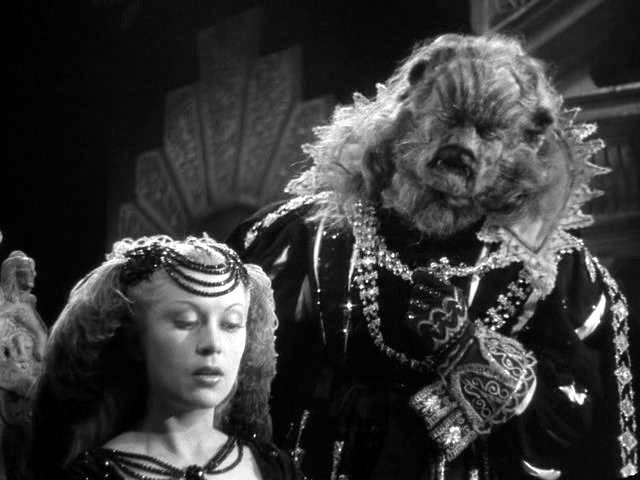
And 2016:
The actress in 1946 had something to interact with, and this is the actor of the beast in full costume. Emma Watson had this guy in this ridiculous costume to interact with.
The Beast in 1946:

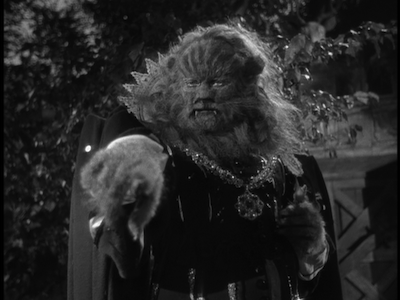
And in 2016:

And then people seriously wonder why so many people don´t like CGI and prefer the old movies? I mean, it´s not only the CGI, also the style, the look of everything, for example the lighting. In the old movie you had more artificial lighting, but the light in the new one just looks like every other movie nowadays, actionmovie, horrormovie, whatever.
It´s kinda sad :(
Greetings,
Sandra
-
It would be great if the people who have done the Blu-ray, the remastering (or whatever) would write something about their decisions in a booklet.
In records of classical music that is played historically informed, it´s quite usual that the conductor writes in a booklet about his decicions, why he choose a certain tempo, certain instruments, a certain size of the orchestra, etc.
On the back of the BD they say: (Translation from German into English by me)
Frame per frame carefully restored and digitally remastered with the help of the original 65mm camera negative.
That´s all. I don´t know what they mean with "with the help of the original negative". Did they use it as a reference for colors?
Greetings,
Sandra
-
The red cloak is practically glowing. The skin is a bit too saturated as well, makes it look like heavy pancake make-up (which is also probably true.)
Ah, I see what you meant, thank you :)
There is another example with big differences, and I´m not sure about that either. Did the company change the original colors with modern filters on the Blu-ray?
For me, the BD-version looks too dark for me, the colors too "modern", while the DVD version has that "old movie" look.
Greetings,
Sandra
-
Anyway, the blu-ray timing of "Ben-Hur" seems like an improvement, the old one seems oversaturated like it is attempting a faux day transfer look.
Where do you see the oversaturated colors? I´m not experienced in seeing that stuff, that´s why I´m asking. For me it looks more like the DVD has less color (orange instead of reds), the stones on the bottom are grey etc.
Where do you see the differences?
Greetings,
Sandra
-
Some say that Leone wanted a stock that has this yellowness, so the movie was supposed to look like that. But I don´t know anything about any film stocks, so I can´t tell whether they are right or wrong. When I read that, I thought, Eastmancolor aways has yellowness.
I bought the Ben Hur Blu-ray last year and I´m amazed about the picture quality! All the details! But now I´m not sure about the colors. Imdb.com says it was also shot in Eastmancolor. Here is a comparison between the old DVD and the Blu-ray:
It doesn´t look as extreme as the "Good, Bad, Ugly"-movie does. The red color looks more like red, not orange. But maybe the sky isn´t correct, and the stones on the bottom of the picture are a bit too brown, instead of grey. I don´t know.
Greetings,
Sandra



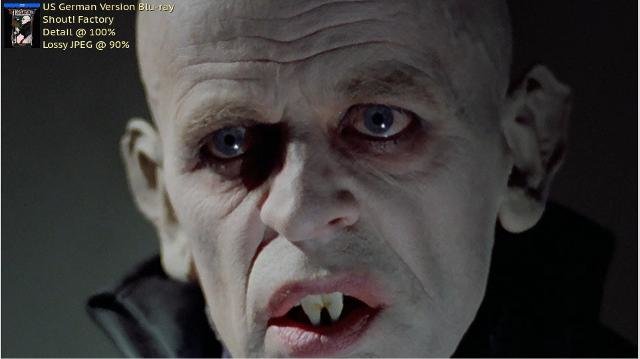
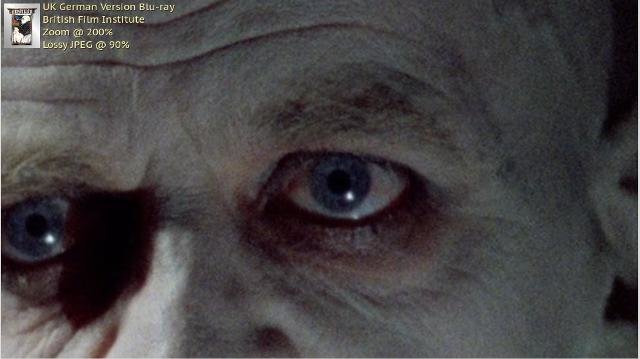

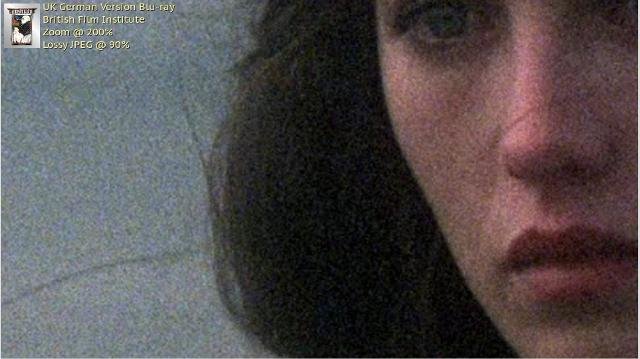

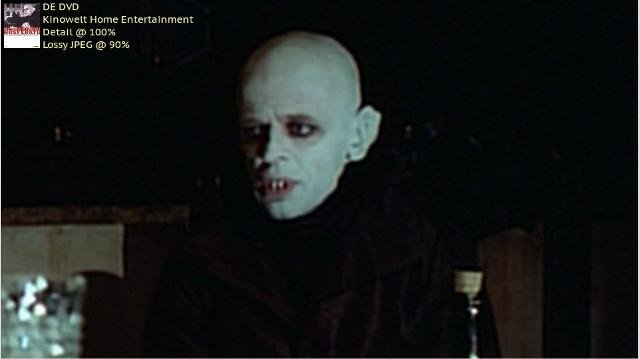

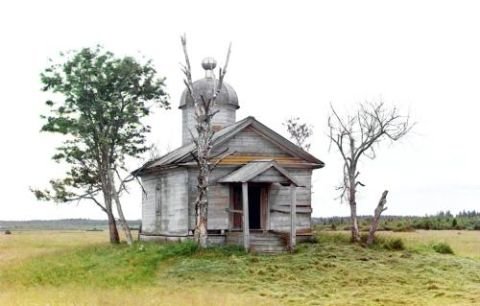
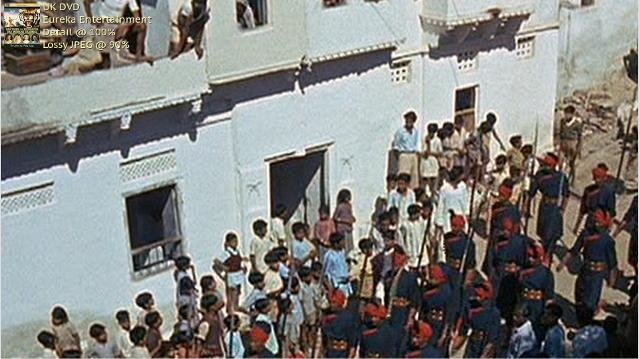

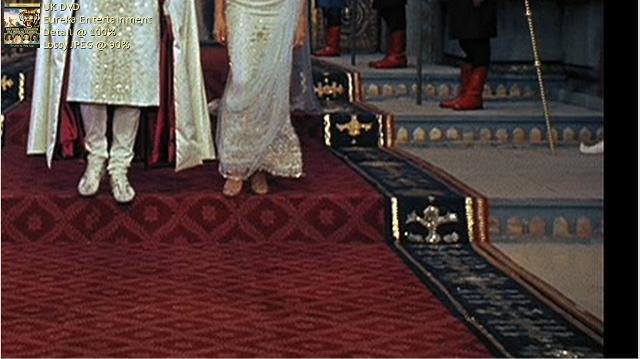
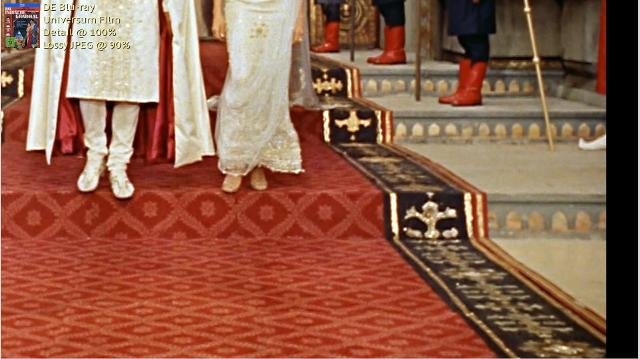
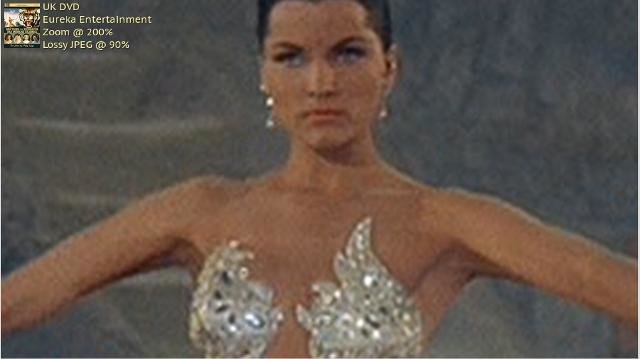
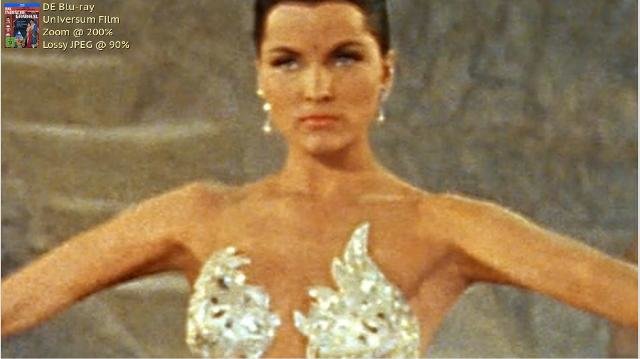
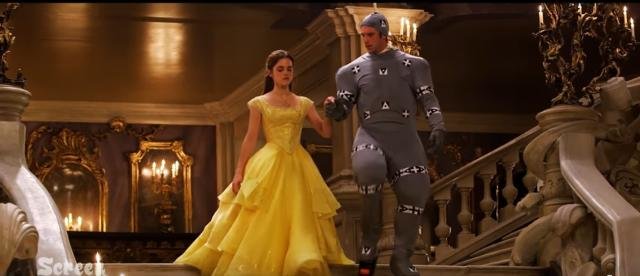
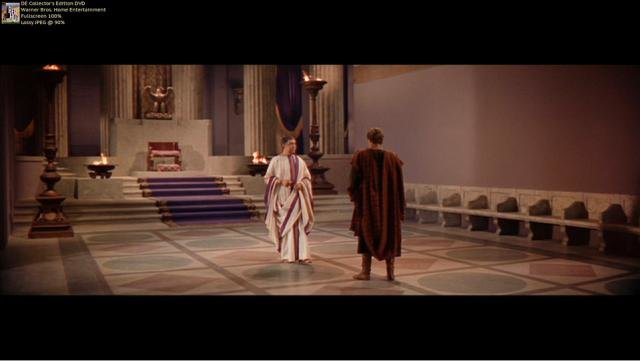
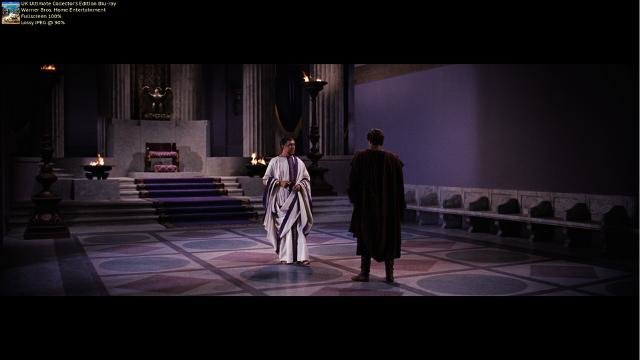
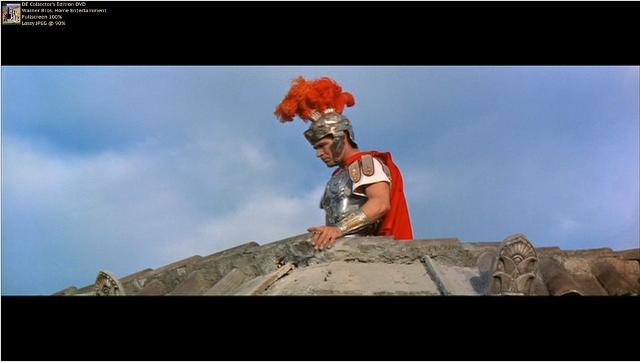
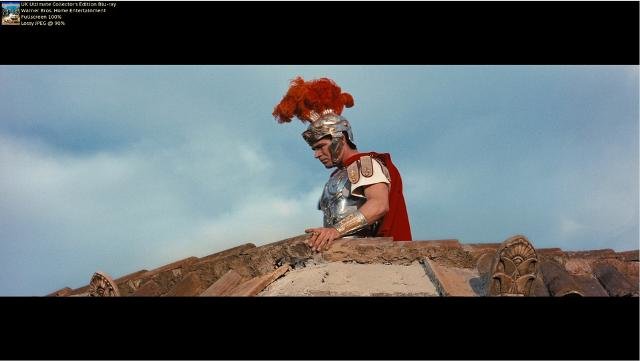
Good Movies about lesbianism
in On Screen / Reviews & Observations
Posted · Edited by Sandra Merkatz
Why?